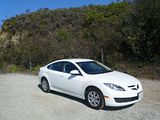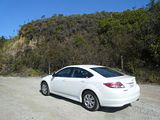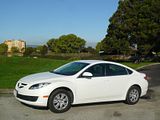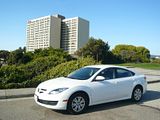



































































Just as with the Fusion, I was disappointed by the steering feel on this car. Gone was what so impressed with the previous generation 6, and what I had here was what my notes called “loose” steering which was a bit too light. It did gain some weight and feel as you put on more lock, but this was far from the precise set up that I recalled from my previous test car. This slight feeling of lightness or sloppiness permeates through to the handling, as well, which was not quite as taut as I recall from the last model. It is nothing of concern, and with little body roll and typical front wheel drive characteristics including a modicum of understeer, taking this car on the Skyline Drive in the hills up above San Jose was still quite rewarding, though I cannot help but feel that I would have enjoyed the driver more in the older car. This one certainly rides well, with no cause for concern or complaint. There were no issues with the brakes, which worked just fine. A pull up handbrake is fitted between the seats. Despite the fact that you can’t see the front or back of the car, it was quite easy to position on the road and not unduly difficult to park, as I found out when I needed to squeeze into a couple of tight spaces by parallel parking. There is a good field of vision from the mirrors, though there is a small blind spot area which needs to be noted.
I am not sure that I would award many prizes for the interior design of the Mazda 6. For a start, it was almost unrelentingly all black, with just a trace of silver on the steering wheel hub and surrounding the audio unit to provide a visual lift. The plastics look hard and a bit cheap, though when you touch them, actually they are softer than you expect. The overall effect is one that is that bit more stylised than in the first generation car, with a curve in and then a rolled surface out towards the lower part of the moulding which serves no practical purpose. There are four dials, each surrounded with a chrome ring, and quite deeply recessed for that “sporting” look. The larger pair are for speedo and rev counter and even these look a bit fussy, with a lot of calibration marks around the outside. The centre of the dash contains the AM/FM and CD capable audio unit, mounted quite high up. Some rather fiddly repeater buttons are on the steering wheel boss. Below this are three simple rotary dials for the air conditioning functions. Other functions are delivered by the twin column stalks, covering indicators, wipers and lights. It is all very simple and very conventional. This model of the Mazda had a plastic moulded steering wheel, and of its genre, it was less unpleasant than most.
Given the one of the design objectives of this car was to make more size for people in it, then you could say Mazda succeeded. The steeply sloping roofline means that you do have to duck slightly when getting into the back, but once installed, there is plenty of headroom. There is ample legroom as well, and enough width for three adults to sit quite comfortably in the car. So, in this respect, the designers did succeed. There is a good sized boot, too. It is wide, stretching right across the car and quite long from front to back, even though there is quite a stubby tail to the Mazda. The rear seat backrests fold forward so you can get far more length if required. There is no extra space for anything under the boot floor. Inside the passenger compartment, the front seat occupants have a pair of door bins, a decent sized glovebox, quite a deep space under the central armrest and a rather small stowage area in front of the gearlever. There are two cupholders under a covering flap in the centre console. Rear seat occupants do not get door bins so are limited to the map pockets in the seat backs.








There is nothing fundamentally wrong with the Mazda 6, but the US press were right to be a little disappointed with this car, as it lacks the ZoomZoom sparkle that made its predecessor a level of fun above its then competitors. I don’t think this version is any worse than the dread 5 rivals that outsell it, and indeed would take one in preference to a Camry every time. but nor is it any better than them in any significant area, so if there was a line of all the rival cars at the rental compound and I was asked to pick one, I would probably walk past this Mazda and get in either the Ford or the Nissan Altima, However, time is almost up for this second generation Mazda 6. Production has recently ceased, and whilst no US market successor has yet been revealed, it has been announced that the third generation model will be the global car, so expect it to be very similar to the stunningly good looking new model that was premiered in Moscow in August 2012. It will be made in Japan, not Michigan, which could trouble Mazda from a pricing point of view, but with those good looks and the promise of the SkyActiv engine, my expectations are that this could be the car to fight very hard for class honours again.




























